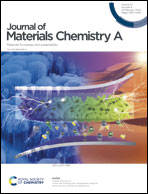Graphynes: ideal supports of single atoms for electrochemical energy conversion†
Abstract
Single atom catalysts (SACs) with maximum atom utilization, well-distributed active sites, and various metal–support interactions have been proven to be new frontiers in electrocatalysis. A suitable support is usually desirable for SACs to prevent the aggregation of metal atoms and improve their dispersity, thereby enhancing their performance for electrochemical energy conversion. Graphynes (GYs), the rising stars of two-dimensional carbon allotropes with monolayer thickness, are composed of sp- and sp2-hybridized carbon atoms. The presence of sp-hybridized carbon atoms in GY networks endows them with unique structures and properties, such as well-distributed pores, high carrier mobility, excellent stability, a large specific surface area, and superior electrical conductivity. These unique structures and properties make GYs ideal supports for SACs. In this review, the feasibility of applying GYs as supports for SACs is analyzed with respect to the structure and properties. Then, various synthetic methods for GY-supported SACs are summarized. Moreover, the applications of GY-supported SACs for electrochemical energy conversion are summarized. Finally, the challenges and future research directions of GY-supported SACs for further development are highlighted. We believe that such a comprehensive summary not only provides a profound understanding of GY-supported SACs for electrochemical energy conversion, but also opens up promising channels for SAC design.



 Please wait while we load your content...
Please wait while we load your content...